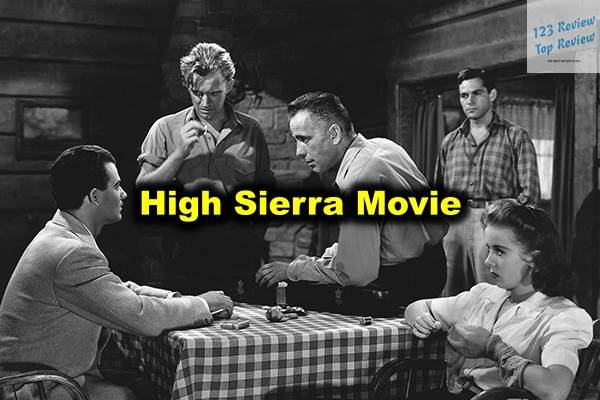The movie tells the story of Roy Earle, a hardened criminal fresh out of prison, who is drawn into one last heist in the rugged Sierra Nevada mountains. As Earle grapples with his past and contemplates his future, the film explores themes of redemption, fate, and the relentless march of time. “High Sierra” not only cemented Bogart’s status as a leading man but also marked a turning point in Hollywood’s portrayal of anti-heroes.
Overview of High Sierra
Film Details
High Sierra is a 1941 crime drama that stands as a pivotal work in the history of American cinema. Directed by Raoul Walsh and adapted from the novel by W.R. Burnett, the film is a cornerstone in the crime genre and a precursor to the film noir movement. Humphrey Bogart stars in a career-defining role as Roy “Mad Dog” Earle, a hardened criminal with a glimmer of decency and humanity beneath his rough exterior. The film also features a strong performance by Ida Lupino as Marie Garson, a woman who falls for Earle despite the dangers that surround him.

The story unfolds against the rugged backdrop of the Sierra Nevada mountains, which serve as both a physical and metaphorical barrier for the characters. The screenplay, co-written by Burnett and John Huston, is tight, gritty, and layered with moral ambiguity, making High Sierra not just a crime story, but a profound exploration of the human condition. Warner Bros. produced the film, further cementing the studio’s reputation for producing hard-hitting, socially conscious dramas.
Release Information
High Sierra was released on January 25, 1941, by Warner Bros. at a time when the United States was on the brink of entering World War II. This context added a layer of tension and resonance to the film, as audiences were increasingly drawn to stories that reflected the harsh realities of life. The movie runs for 100 minutes and was well-received by both critics and audiences upon its release.
Its release was strategically timed to take advantage of the growing popularity of crime dramas, and it benefited from the emerging star power of Humphrey Bogart, who was just beginning to establish himself as a leading man. The film’s success at the box office was a testament to its gripping narrative and the compelling performances of its cast.
Box Office Performance
High Sierra was a commercial success, grossing over $1 million at the box office—a significant sum during the early 1940s. This success was particularly impressive given the economic uncertainties of the time and the increasing competition from other major releases. The film was one of Warner Bros.’ top earners for the year, further solidifying the studio’s dominance in the crime drama genre.
The box office performance of High Sierra also had a lasting impact on Humphrey Bogart’s career. Prior to this film, Bogart had primarily been cast in supporting roles, often as a villain or secondary character. However, the critical and commercial success of High Sierra marked the beginning of his ascent to superstardom, leading to iconic roles in films like The Maltese Falcon (1941) and Casablanca (1942).
Cast and Characters
Main Cast
- Humphrey Bogart as Roy “Mad Dog” Earle: The protagonist of the film, Roy Earle, is a complex character who embodies both the ruthlessness of a career criminal and the vulnerability of a man seeking redemption. Recently paroled from prison, Earle is tasked with leading a heist that he hopes will be his last. Bogart’s portrayal of Earle is both intense and nuanced, capturing the inner conflict of a man torn between his criminal instincts and his desire for a better life.
- Ida Lupino as Marie Garson: Marie is a tough, streetwise woman who becomes romantically involved with Earle. Unlike the other women in Earle’s life, Marie sees him for who he truly is and loves him despite his flaws. Lupino’s performance is both tender and gritty, making Marie one of the most memorable characters in the film. Her loyalty to Earle, even in the face of danger, adds an emotional depth to the story.
- Arthur Kennedy as Red Hattery: Red is one of Earle’s partners in the planned heist. A more reckless and impulsive character, Red contrasts sharply with Earle’s more calculated approach. Kennedy’s portrayal of Red brings a sense of unpredictability to the film, highlighting the tensions within the group of criminals.
- Joan Leslie as Velma: Velma is a young woman who becomes the object of Earle’s affections. Her innocence and vulnerability represent the life Earle wishes he could have. However, Velma is largely indifferent to Earle’s advances, seeing him more as a benefactor than a potential partner. Joan Leslie’s performance captures the naivety and emotional distance of Velma, making her a symbol of unattainable redemption for Earle.
Supporting Cast
- Henry Hull as Doc Banton: Doc is an elderly, world-weary physician who becomes a confidant to Earle. His character provides a voice of reason and experience, offering Earle advice on both his physical health and his existential dilemmas. Hull’s portrayal of Doc adds a layer of philosophical reflection to the film, underscoring its themes of fate and mortality.
- Cornel Wilde as Louis Mendoza: Mendoza is a small-time crook involved in the heist. His character represents the lower rungs of the criminal world, and Wilde’s performance brings out the desperation and fear that drives Mendoza’s actions. His interactions with Earle and the other criminals highlight the varying degrees of loyalty and treachery within the group.
- Barton MacLane as Jake Kranmer: Jake is the lawman on Earle’s trail. Representing the relentless force of justice, Kranmer is determined to bring Earle to justice, no matter the cost. MacLane’s portrayal of Kranmer is stern and uncompromising, making him a formidable antagonist in the film.
- Donald MacBride as Big Mac: Big Mac is the mob boss who orchestrates the heist that Earle is tasked with leading. His character is emblematic of the shadowy, controlling figures that often operate behind the scenes in crime dramas. MacBride’s performance adds a layer of menace and authority to the film, reminding viewers of the broader criminal networks at play.
Character Analysis
The characters in High Sierra are richly drawn, with each playing a crucial role in the film’s exploration of crime, morality, and the human condition. Roy Earle, as the central figure, is a study in contrasts. He is at once a ruthless criminal and a man yearning for a better life, embodying the duality that is central to many film noir protagonists. Bogart’s performance captures this duality, portraying Earle as both a tragic hero and a man doomed by his past.
Marie Garson, played by Ida Lupino, is another complex character. She is tough and streetwise, yet vulnerable in her love for Earle. Her unrequited love and loyalty add a layer of emotional depth to the film, contrasting with the colder, more calculating characters around her. Marie’s relationship with Earle is one of the film’s emotional anchors, providing a counterpoint to the otherwise bleak narrative.
The supporting characters, including Red, Velma, Doc, Mendoza, and Kranmer, each add to the film’s exploration of the criminal world. They represent different facets of that world, from the reckless ambition of Red to the naive innocence of Velma. Each character’s interaction with Earle sheds light on his inner turmoil, making the film as much a character study as it is a crime drama.
Direction and Production
Director: Raoul Walsh
Raoul Walsh, a veteran of the Hollywood studio system, brought his considerable experience to High Sierra. Known for his work in the crime and action genres, Walsh was adept at creating tension and pacing, which are crucial elements of the film’s success. His direction in High Sierra is marked by a focus on realism, both in the depiction of the characters and the use of location shooting in the Sierra Nevada mountains.
Walsh’s approach to the material was both dynamic and psychological. He understood the importance of character development in a story like High Sierra and allowed the actors, particularly Bogart and Lupino, to explore the complexities of their roles. At the same time, Walsh maintained a tight narrative pace, ensuring that the film remained gripping from start to finish. His direction is often cited as one of the key reasons for the film’s enduring success.
Screenplay and Screenwriters
The screenplay for High Sierra was the result of a collaboration between W.R. Burnett, who authored the original novel, and John Huston, who would later become a legendary director in his own right. Burnett’s experience in writing hard-boiled crime fiction lent the script an authenticity and grit that is palpable throughout the film. His understanding of the criminal underworld and its inhabitants is evident in the richly detailed characters and their interactions.
John Huston, who was relatively new to screenwriting at the time, brought a sharpness and wit to the dialogue, as well as a deep understanding of character psychology. His contributions helped to elevate the screenplay beyond a typical crime story, infusing it with layers of moral ambiguity and existential reflection. The collaboration between Burnett and Huston resulted in a screenplay that is both taut and emotionally resonant, contributing to the film’s lasting impact.
Production Company
High Sierra was produced by Warner Bros., a studio that had built its reputation on producing gritty, socially conscious dramas and crime films. During the 1930s and 1940s, Warner Bros. was known for its focus on realism and its willingness to tackle difficult subjects, including crime, corruption, and social inequality. High Sierra fits squarely within this tradition, offering a stark portrayal of the criminal world and the consequences of a life of crime.
The production values of High Sierra reflect Warner Bros.’ commitment to high-quality filmmaking. The studio invested in on-location shooting, which added authenticity to the film’s setting, and ensured that the film’s technical aspects, including cinematography and editing, were handled by top professionals. The success of High Sierra reinforced Warner Bros.’ position as a leader in the crime genre and helped to pave the way for the studio’s continued dominance in the film noir movement.
Themes and Motifs
Crime and Morality
One of the central themes of High Sierra is the exploration of crime and morality. The film delves deeply into the psyche of its protagonist, Roy Earle, a man who has spent much of his life on the wrong side of the law. Despite his criminal background, Earle is portrayed as a man with a moral compass, albeit one that has been skewed by years of hardship and betrayal.
The film poses complex questions about fate, free will, and the possibility of redemption. Earle’s journey is marked by his struggle to reconcile his past with his desire for a better future. His interactions with other characters, particularly Marie and Velma, force him to confront the consequences of his actions and the choices that have led him to this point. The film ultimately suggests that while redemption may be possible, it often comes at a high cost.
Pursuit and Isolation
The motif of pursuit is a dominant theme in High Sierra, both in the literal sense of Earle being pursued by the law and in the metaphorical sense of his pursuit of peace and redemption. Earle is constantly on the run, not only from the authorities but also from his own demons. This sense of relentless pursuit is reflected in the film’s pacing and its tense, suspenseful atmosphere.
Isolation is another key motif, both physical and emotional. Earle is isolated from society, not only by his criminal status but also by his inability to connect with others on a deeper level. This isolation is symbolized by the remote, rugged landscape of the Sierra Nevada mountains, which serves as both a refuge and a prison for Earle. The film’s use of setting to reflect its themes is one of its most striking elements, adding a layer of visual symbolism to the narrative.
Love and Sacrifice
Love and sacrifice are intertwined in High Sierra, particularly in the relationships between the characters. Earle’s love for Velma is marked by a willingness to sacrifice his own desires for her happiness, even when it becomes clear that she does not return his affections. This unrequited love is one of the most poignant aspects of the film, highlighting Earle’s longing for a connection that he ultimately cannot have.
Marie’s love for Earle, on the other hand, is characterized by a deep loyalty and a willingness to stand by him despite the dangers that surround them. Her sacrifices, both emotional and physical, underscore the film’s exploration of love as a double-edged sword—something that can bring both joy and pain. The theme of sacrifice is further reinforced by the film’s tragic ending, which suggests that true love often requires the ultimate sacrifice.
Cinematography and Visual Style
Location Shooting
One of the most distinctive aspects of High Sierra is its use of on-location shooting in the Sierra Nevada mountains. The rugged, unforgiving landscape serves as a powerful backdrop to the story, emphasizing the themes of isolation and pursuit. The natural setting adds an element of realism to the film, making the characters’ struggles feel more immediate and visceral.
The decision to shoot on location also distinguishes High Sierra from other crime dramas of the era, many of which were confined to studio sets. The vast, open spaces of the Sierra Nevadas contrast sharply with the claustrophobic interiors that dominate much of the film, creating a dynamic visual tension. This use of location is not just a stylistic choice but a narrative one, as the landscape becomes a character in its own right, shaping the events of the story.
Camera Techniques
Raoul Walsh and his cinematographer, Tony Gaudio, employed a variety of camera techniques to heighten the tension and emotional impact of High Sierra. The film makes extensive use of tight close-ups, particularly during moments of high drama, to capture the inner turmoil of the characters. These close-ups allow the audience to see the subtle shifts in expression that reveal the characters’ unspoken thoughts and emotions.
The film also uses long shots to great effect, particularly in the scenes set in the mountains. These shots emphasize the vastness of the landscape and the smallness of the characters within it, reinforcing the theme of isolation. The combination of close-ups and long shots creates a visual rhythm that mirrors the emotional ebb and flow of the narrative.
Use of Lighting
The use of lighting in High Sierra is another key element of its visual style, drawing on the techniques of German Expressionism that would become a hallmark of film noir. The film makes extensive use of low-key lighting, creating deep shadows and stark contrasts that reflect the moral ambiguity of the characters. This chiaroscuro effect adds a layer of visual complexity to the film, emphasizing the duality of Earle’s character and the tension between light and dark, good and evil.
Lighting is particularly important in the film’s nighttime scenes, where the interplay of light and shadow creates a sense of danger and uncertainty. The use of backlighting, in particular, is effective in creating a silhouette effect that heightens the sense of mystery and foreboding. These lighting techniques contribute to the overall atmosphere of the film, making High Sierra not just a crime drama, but a visually striking exploration of the darker side of human nature.
Critical Reception
Reviews and Ratings
Upon its release, High Sierra was met with widespread critical acclaim. Reviewers praised the film for its gripping narrative, strong performances, and atmospheric direction. Humphrey Bogart’s portrayal of Roy Earle was singled out for particular praise, with many critics noting it as a breakthrough role for the actor. Bogart’s ability to convey the complexity of Earle’s character—his toughness, vulnerability, and ultimate tragedy—was seen as a major factor in the film’s success.
Ida Lupino’s performance as Marie Garson also received accolades, with critics appreciating her ability to bring depth and nuance to a character who could have easily been reduced to a stereotype. The chemistry between Bogart and Lupino was noted as one of the film’s highlights, adding emotional weight to the story.
Over the years, High Sierra has maintained its reputation as a classic of American cinema. It holds a high rating on platforms like Rotten Tomatoes and continues to be studied and analyzed by film scholars. Modern critics have noted the film’s significance in the development of film noir and its influence on later crime dramas.
Significance in Film Noir
High Sierra is often cited as a precursor to the film noir movement that dominated Hollywood in the 1940s and 1950s. While not a full-fledged noir in the way that later films like Double Indemnity (1944) or The Big Sleep (1946) would be, High Sierra contains many of the elements that would come to define the genre. These include its morally ambiguous protagonist, its exploration of fate and fatalism, and its use of shadowy, expressionistic lighting.
The character of Roy Earle, in particular, can be seen as a prototype for the classic noir anti-hero. Earle is a man caught between his desire for redemption and his inability to escape his past, a theme that would become central to many noir films. The film’s exploration of crime, morality, and the human condition also aligns with the thematic concerns of noir, making High Sierra an important stepping stone in the genre’s evolution.
Influence on Later Films
The influence of High Sierra can be seen in numerous films that followed, particularly in the crime and noir genres. Its themes of fatalism, moral ambiguity, and the complex nature of the criminal mind have been echoed in countless films, from classic noirs like Out of the Past (1947) to more modern crime dramas like Heat (1995). The film’s portrayal of a tragic, flawed protagonist seeking redemption has become a staple of the genre.
High Sierra also had a significant impact on the careers of those involved, particularly Humphrey Bogart. The success of the film led directly to his casting in The Maltese Falcon, another milestone in the noir genre, and established him as one of Hollywood’s top leading men. The film’s influence extends beyond the crime genre, as its character-driven narrative and exploration of moral complexity have inspired filmmakers across various genres.
Legacy and Remakes
Impact on Humphrey Bogart’s Career
High Sierra was a turning point in Humphrey Bogart’s career. Prior to this film, Bogart had often been typecast as a supporting player or a villain, with few opportunities to showcase his range as an actor. However, his portrayal of Roy Earle in High Sierra demonstrated his ability to carry a film as a leading man, and it opened the door to a series of iconic roles that would define his career.
The film’s success also helped to establish Bogart’s tough-guy persona, which would become a key element of his screen presence in later films. His roles in The Maltese Falcon, Casablanca, and To Have and Have Not (1944) all built on the foundation laid by High Sierra, making him one of the most beloved and enduring stars in Hollywood history.
Adaptations and Inspirations
High Sierra has inspired several adaptations and remakes over the years, each of which has added to its legacy. The first remake was Colorado Territory (1949), a Western directed by Raoul Walsh, who reimagined the story in a frontier setting. While the setting and some details were changed, the core themes and character dynamics remained intact, demonstrating the story’s versatility and timelessness.
Another notable remake is I Died a Thousand Times (1955), starring Jack Palance in the role of Roy Earle. This version stayed closer to the original, updating the story for a new generation of audiences. While neither remake achieved the same level of acclaim as the original, they both attest to the enduring appeal of High Sierra and its central narrative.
In addition to these direct remakes, High Sierra has influenced numerous other films, both within the crime genre and beyond. Its themes of redemption, fate, and the complexities of the criminal mind have been explored in countless movies, from classic noirs to modern thrillers. The film’s impact can also be seen in television, literature, and other media, where its influence continues to resonate.
Place in Film History
High Sierra occupies a significant place in the history of American cinema. As one of the early examples of a film that blends the crime drama with deeper psychological and moral themes, it helped to pave the way for the film noir movement and influenced the direction of Hollywood storytelling in the 1940s and beyond. Its success also marked a turning point in the careers of its stars, particularly Humphrey Bogart, who would go on to become one of the most iconic actors of all time.
The film is also notable for its use of location shooting and its realistic portrayal of the criminal underworld, both of which were innovative for their time. Its legacy is reflected in the numerous remakes, adaptations, and homages that have followed, as well as in the continued appreciation of critics, scholars, and audiences.
In conclusion, High Sierra is more than just a crime drama; it is a rich, multi-layered film that explores complex themes of morality, redemption, and the human condition. Its place in film history is secure, not only as a precursor to film noir but as a classic in its own right, with a legacy that continues to inspire and influence filmmakers to this day.





